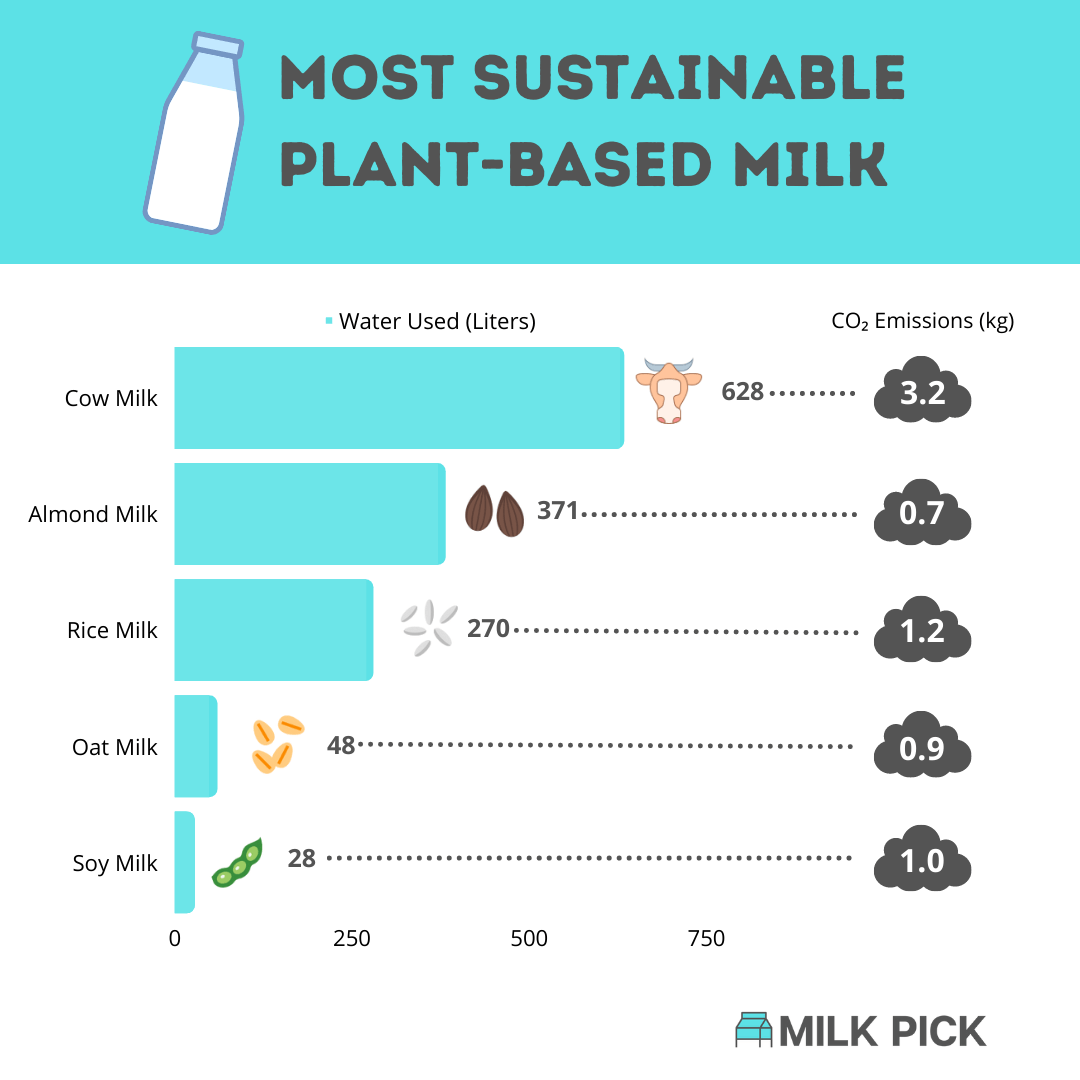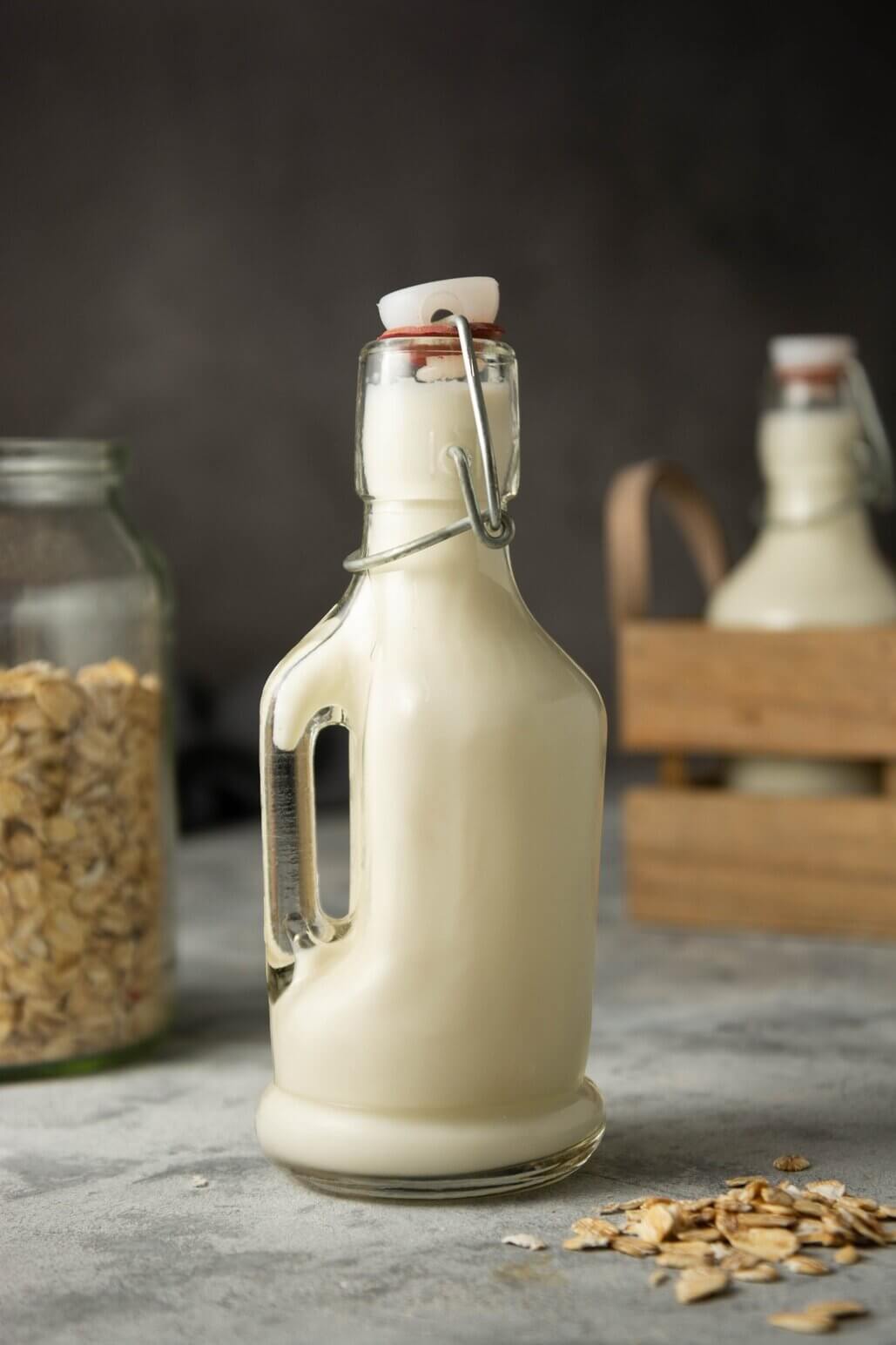Many people have spoken out about almond milk’s potentially negative impact on the environment.
If you switch from almond or dairy milk to oat milk, you may wonder if oat milk is a more environmentally sound plant-based milk option.
Oat milk is not bad for the environment. In fact, oat milk is one of the best types of milk for the environment because it requires minimal water and land to manufacture.
Learn more about oat milk’s effect on the environment, including the farming and manufacturing process and how oat milk’s impact stacks up against other milk options.
Impacts of Oat Milk on the Environment
Determining the impact of oat milk on the environment is a complex undertaking.
Multiple factors play a part in understanding the effect that farming and manufacturing oat milk has on the Earth’s climate and atmosphere.
The main factors to consider are:
- Greenhouse gas emissions
- Water usage
- Land usage
- Ecological impact
Greenhouse Gas Emissions
Greenhouse gases, such as carbon dioxide, methane, and nitrous oxide, trap heat in the earth’s atmosphere.
These gasses happen as a result of agricultural, manufacturing, and transportation processes and contribute to pollution and global warming.
It’s impossible to grow and manufacture oat milk without some type of greenhouse gas emission.
However, oat milk has one of the lowest carbon footprints of all milk types at approximately .40 pounds per 7-ounce glass.
Water Usage
Water usage plays a part in oat milk’s impact on the environment.
Farmers use nearly 48 liters (13 gallons) of water to produce one liter of oat milk.
Compared to the 628 liters of water it takes to produce the same amount of cow milk and 371 liters to produce almond milk, oat milk has much less impact on water scarcity issues.
Additionally, oats are primarily grown in cool, temperate zones rather than warm climates.
Unlike California, which is experiencing record-breaking droughts and wildfires, oat-producing farms in other states have better access to water.

Land Usage
For other non-dairy milk, land usage is a major concern for environmental impact.
For example, almond milk uses about 1.6 million acres of California’s nearly 105 million total land acreage.
This means that almonds take up a significant portion of the limited agricultural land supply.
On the other hand, oats are mainly grown in the rich agricultural land of the U.S. Midwest.
Nearly 3.1 million acres of oats are planted every year out of the country’s 2.43 billion acres of land.
33% of the U.S.'s oat production comes from South Dakota and Minnesota, which have ample land to grow the crop.
Oats are also grown in Pennsylvania, Texas, Kansas, and Nebraska because they don’t require strict climate-growing requirements.
This makes oat milk’s impact on land usage much less problematic than other plant-based milk.

Ecological Impact
Ecological impact refers to a product's effects on the Earth’s ecosystems, such as plant and animal life.
According to a 2015 National Agricultural Statistics Service survey, farmers typically use herbicides, fungicides, and pesticides when growing oats.
These include:
- 2,4-D, dimethylamine salt
- glyphosate isopropylamine salt
- Clopyralid monoethanolamine salt
- Fluroxypyr 1-MHE Siwiec
Glyphosate has been found to have low toxicity and environmental impact.
2, 4-D, which is used on around 51% of oats in the U.S., is moderately toxic to birds, fish, and other wildlife.
However, 2, 4-D is not harmful to honeybees.
How is Oat Milk Farmed and Manufactured?
Understanding the farming and manufacturing process of oats can also help determine the environmental impact of oat milk.
Farming Oats
The process of farming oats begins with preparing the ground for planting.
Farmers ready their land a few weeks before planting by putting down suitable fertilizers and tilling the soil.
When the time is right, farmers plant their oat seeds about ¾” to 1” deep. Planting time varies by location throughout the U.S.
However, it is typically towards the beginning or middle of May.
Oats are cold hardy up to about 10°F and can withstand various growing conditions such as heat and cold, wet and dry.
This means they don’t require as much time-consuming cultivation as other crops used for plant milk, such as almonds or cashews.
The oats take a few weeks to germinate once planted and grow quickly as the summer months move in.

Processing Oats
When the oats are ready for harvesting, most farmers use a combined harvester machine to collect the oats.
The harvester pulls the whole oat kernel away from the stem and places it in a compartment with the other oats.
The oats are then transported to a facility for further cleaning and processing.
At the processing facility, the oats are prepared for human consumption.
Machines clean the oats and remove debris like hay, leaves, or dirt.
Then the machines hull the oats, a process which takes off the outer part of the oat called the hull, leaving the groat.
The groat is the edible part of the oat and is further processed based on the manufacturer's needs.
It can be cut to make steel-cut oats, flattened to make old-fashioned oats, or further processed to make quick-cook oats.
Manufacturing Oat Milk
The oats are sent to a manufacturing plant to make oat milk.
The manufacturer combines the oats with water and any additives needed for their product to make oat milk.
Sometimes this process includes pasteurization and further processing.
The process is more straightforward for other products, requiring less machinery and ingredients.
Finally, the oat milk is transported to customers, either to store shelves or directly to the customer’s door.
Related: Is Oat Milk Healthy?
Environmental Considerations About Farming and Manufacturing
Several aspects can affect oat milk’s environmental impact throughout the farming and manufacturing process.
These include:
Pesticides
Most farmers use pesticides, herbicides, and fungicides to protect their crops from damage.
Organic farmers, however, don't use pesticides at all or use a limited range of approved pesticides.
This means that oat milk made with organic oats is likely less impactful on the environment.
Processing and Packaging
The less processing and packing oat milk goes through, the less impactful it is on the environment.
Buying bulk, non-packaged oats to make homemade oat milk has the least environmental impact.
However, you can also opt for oat milk brands with minimal packaging and processing.
Food Waste
In most cases, there is little food waste in farming oats.
When processing facilities remove the hull, it is used to feed livestock rather than thrown out.
When manufacturers make oat milk, they also send the pulp strained from the product to feed livestock.
This is beneficial from a food waste perspective.
It also reduces greenhouse gas emissions because it prevents the release of methane that would occur if the pulp and hull were sent to a landfill to rot.
Transportation
Transportation means more greenhouse emissions, so the shorter distance your oats or oat milk travels to get to you, the better.
Buying local or regionally made oat milk is the best option for the least environmental impact.

Is Oat Milk Better for the Environment Than Other Types of Milk?
When looking at oat milk’s impact on the environment, it’s helpful to see how it stacks up against other milk, including dairy milk and plant-based milk options.
Cow’s Milk
According to a 2018 Oxford University study, cow’s milk is one of the worst types of milk for the environment.
The greenhouse emissions linked to one cup of cow’s milk can be three times higher than any other plant-based beverage.
The study found that 7 ounces of cow’s milk produce about .6 pounds of carbon dioxide.
It also takes between 628 liters (165.9 gallons) and 1050 liters (277.4 gallons) of water to make 1 liter (quarter gallon) of cow milk.
Almond Milk
Almond milk sales outrank all other plant-based milk sales worldwide.
Although it may not have as negative an effect on the environment as some claim, once all factors are considered, it does use up more resources to produce than oat milk.
7-ounces of almond milk has a carbon footprint of about .31 pounds and uses nearly 200 gallons of water for one serving.
Soy Milk
Compared to dairy milk and almond milk, soy milk is a more sustainable solution.
A one-quarter gallon of soy milk takes about 78 gallons of water to produce, slightly more than oat milk’s 13 gallons.
Soy milk’s carbon dioxide emissions are 33% less than dairy milk at .43 pounds per quarter gallon and only a few tenths over oat milk.
Rice Milk
Rice milk may have a more negative impact on the environment than all other plant-based milk types.
It ranks just under dairy milk for emissions and water use, according to the 2018 Oxford study.
Rice milk uses less land to produce than oat milk but outranks all but almond milk and other factors.
Pros and Cons of Oat Milk For the Environment
There are several pros and cons to consider when looking at the impact of oat milk on the environment.
Pros:
- Low carbon footprint
- Low water usage
- Land usage is spread out, and sustainable
- Less transportation is required, which means fewer emissions
- Growing oats may reduce carbon dioxide in the air
Cons:
- Many oat farmers use pesticides which can negatively impact wildlife
- Water usage is higher than that of soy milk

How To Minimize Oat Milk’s Impact on the Environment
While every manufactured product impacts the environment, oat milk is low on the list of harmful foods.
With its low water and land usage numbers, and low emissions, oat milk is an excellent choice for people looking for a healthy non-dairy milk.
If you want to minimize the environmental effects of oat milk, consider buying from smaller companies or those who use organic oats.
Since pesticide use is one of the only cons of oat milk production, drinking brands like Willa’s oat milk or Thrive Market oat milk help support organic growers who don’t use pesticides.
You can also make oat milk at home using organic, whole-grain oats.
Whole-grain oats go through minimal processing, which reduces their overall greenhouse gas emissions.
Is Oat Milk Bad For the Environment?
No. When it comes to the environment, oat milk is one of the best options you can choose to replace cow or almond milk.
The best oat milk you can buy uses organic, whole-grain oats and require minimal processing and transportation to produce.
If you are eco-conscious, you can enjoy your glass of oat milk, knowing it has a minimal effect on the environment.
